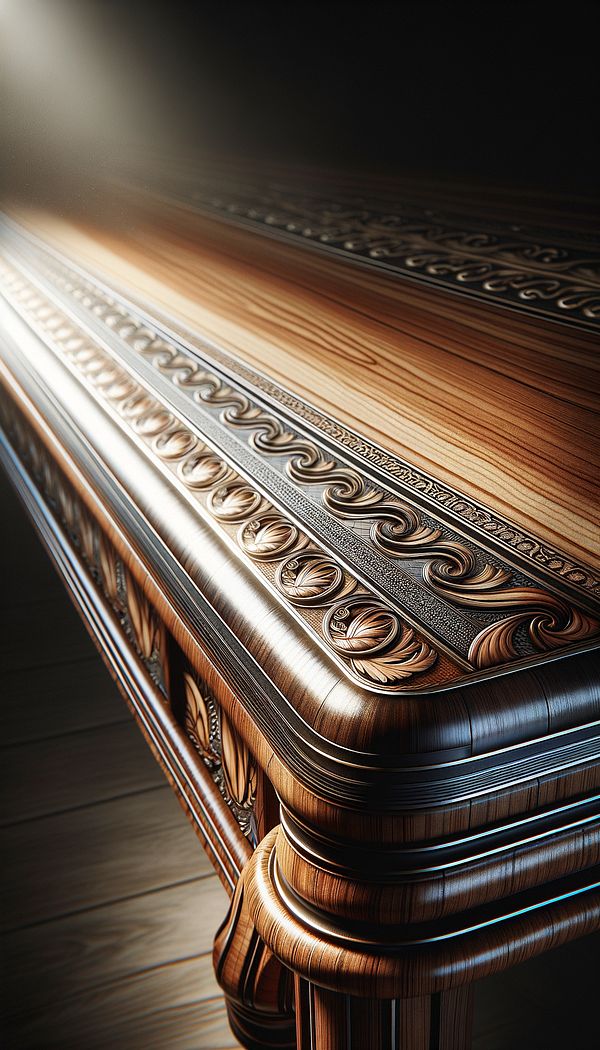What is Banding?
Banding refers to the decorative detail created by applying strips of material to the edges or borders of furniture, textiles, or architectural features.
Description
Banding, in the realm of interior design, is a decorative and functional technique that involves adding strips of material to the borders or edges of various design elements. This practice is common across furniture, textiles, and architectural details, where banding serves to enhance visual appeal or cover seams and transitions between materials. The materials used for banding can vary widely, but often include metal, wood, veneer, and fabric, depending on the context and desired aesthetic.
In furniture, banding is frequently employed to accentuate the edges of tabletops, cabinets, or drawers, often using contrasting wood grains or materials. For textiles, such as curtains or upholstery, banding can add a pop of color or texture at the edges or seams, providing a sophisticated finish. Architecturally, banding can refer to the application of strips at transitions between different materials or at the base and crown of walls, subtly delineating spaces or features within a room.
Overall, banding is a detail-oriented design strategy that can bring cohesion, contrast, or emphasis to various interior elements, harmonizing with broader design themes and enhancing the overall aesthetic of a space.
Usage
A classic example of banding usage is in marquetry furniture, where thin strips of contrasting wood or metal are inlaid into the edges of tables, offering a refined and decorative edge. In modern designs, banding might be seen in the form of a brightly colored fabric trim added to neutral upholstery, providing a distinctive accent that ties into the room's color scheme. Architecturally, banding can manifest as a simple wooden trim at the junction between a painted wall and ceiling, subtly defining the space while adding architectural interest.
FAQs
-
Can banding be applied to any furniture surface?
Yes, banding can be applied to nearly any furniture surface, but it is most commonly found on flat surfaces such as tabletops and sides of cabinets where it can create the most impact by framing or accentuating the piece.
-
Does banding only use contrasting materials?
Not necessarily. While using contrasting materials can accentuate the banded area and add visual interest, banding can also employ materials that blend with the main body for a more subtle, seamless look.
-
Is banding purely decorative, or does it serve a functional purpose as well?
Banding serves both decorative and functional purposes. Decoratively, it adds visual interest and can highlight features of a piece. Functionally, it can help protect edges from wear and tear or conceal joints and seams.
Practical Application
When incorporating banding into your design, consider the overall aesthetic and the statement you wish to make. For a bold impact, select materials that contrast with the main body, whether in color, texture, or pattern. For a more subtle approach, choose banding materials that complement the primary material. Remember, the width and placement of the banding can significantly affect the final look, so experiment with different options before finalizing your design.
-
Architectural Elements199 articles
-
Design Styles478 articles
-
Furniture Types599 articles
-
Decorative Techniques322 articles
-
Materials & Textiles360 articles
-
BowfrontBowfront refers to a piece of furniture that has a curved front.
-
FixtureIn interior design, fixtures refer to items that are attached to the property in a way that makes them a permanent part of the space.
-
RenaissanceThe Renaissance is a historical period and artistic movement characterized by a revival of interest in classical art, architecture, and knowledge.
-
IntaglioIntaglio is a decorative technique where the design is engraved into a material.
-
RomanesqueRomanesque is a style of architecture and design characterized by semi-circular arches, thick walls, and sturdy pillars.
